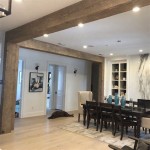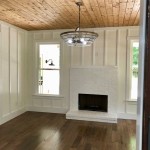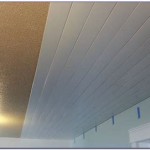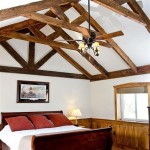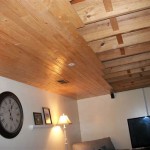How To Cover Popcorn Ceilings: A Comprehensive Guide
Popcorn ceilings, officially known as acoustic ceilings, were a popular choice in residential construction from the 1950s through the 1980s. Their textured appearance was designed to dampen sound, hide imperfections, and potentially offer some fire-resistant qualities. However, aesthetic preferences have shifted, and many homeowners now seek to remove or cover these ceilings due to their dated look, potential for asbestos content (in older homes), and difficulty in cleaning.
While complete removal is an option, it can be a messy and time-consuming process, especially if asbestos is present, necessitating professional abatement. Covering the popcorn ceiling presents a viable alternative, offering a cleaner, less invasive way to update the appearance of a room. This guide provides a comprehensive overview of the methods and considerations for successfully covering a popcorn ceiling.
Evaluating the Existing Ceiling
Before embarking on any covering project, a thorough evaluation of the existing popcorn ceiling is essential. This assessment will determine the best approach and help avoid potential pitfalls.
The first step involves identifying the age of the ceiling. Homes built before the 1980s may contain asbestos in the popcorn texture. Asbestos poses a health risk if disturbed, so testing is crucial. A professional asbestos testing service should be employed to collect a sample and analyze it. If asbestos is present, professional abatement is the safest and often legally required course of action. Attempting to remove or cover an asbestos-containing ceiling without proper precautions can release harmful fibers into the air.
Next, assess the structural integrity of the existing ceiling. Look for signs of water damage, cracks, or sagging. Any underlying issues must be addressed before covering the ceiling. Water damage, for instance, can lead to mold growth and structural failure. Repairing these problems ensures a stable and sound base for the covering material.
Consider the texture's thickness and consistency. Heavily textured ceilings may require more preparation or a thicker covering material. Uneven textures can create challenges in achieving a smooth, uniform finish. A consistent texture will simplify the covering process and yield a more aesthetically pleasing result.
Finally, determine the existing ceiling height. Adding a layer of covering material will slightly lower the ceiling. In rooms with already low ceilings, this reduction in height could be undesirable. Carefully measure the ceiling height and factor in the thickness of the chosen covering method.
Methods for Covering Popcorn Ceilings
Several effective methods exist for covering popcorn ceilings, each with its own advantages and disadvantages. Here's an overview of the most common techniques:
1. Skimming with Joint Compound:
This method involves applying multiple thin layers of joint compound over the existing popcorn texture, effectively creating a smooth, flat surface. It's a labor-intensive process but allows for a seamless and paintable finish.The preparation involves scraping off any loose or flaking texture using a wide taping knife. This minimizes imperfections and ensures good adhesion of the joint compound. Apply a bonding primer to the popcorn texture to improve adhesion of joint compound. Bonding primers are designed for this purpose and will reduce the likelihood of the compound peeling or cracking.
Apply the first coat of joint compound using a wide taping knife (10-12 inches is recommended). Press firmly to fill in the texture and create a relatively smooth surface. Allow the first coat to dry completely before applying subsequent coats. Drying times vary depending on humidity and temperature. Multiple coats, typically two to three, are needed to completely conceal the popcorn texture. Each coat should be thinner than the previous one. Sand each coat lightly after it dries to remove any imperfections and create a smooth surface for the next coat. Use a pole sander with fine-grit sandpaper (120-150 grit) for easier sanding. After the final coat is sanded, apply a primer to seal the surface and prepare it for painting. Use a high-quality ceiling paint for a professional-looking finish.
2. Installing Drywall Over the Existing Ceiling:
This method involves attaching new drywall panels directly to the existing ceiling joists, effectively encapsulating the popcorn texture. It's a faster method than skimming but requires more structural considerations.Locate the ceiling joists using a stud finder. Mark their location on the ceiling for easy reference. Ensure the existing ceiling is securely attached to the joists. If it's loose or sagging, reinforce it with screws before installing the drywall. Measure the room and cut the drywall panels to size. Use a drywall saw or utility knife to make accurate cuts. Lift the drywall panels into place and attach them to the ceiling joists using drywall screws. Use screws of the appropriate length to penetrate the joists securely. Stagger the seams between the drywall panels for added strength and to minimize cracking.
Apply drywall tape and joint compound to the seams and screw holes. This creates a smooth, seamless surface. Sand the dried joint compound to create a smooth transition between the drywall panels. Apply a primer to the drywall to seal the surface and prepare it for painting. Use a high-quality ceiling paint for a professional-looking finish. This method will lower the ceiling slightly more than skimming, so it's important to consider existing ceiling height.
3. Installing Tongue-and-Groove Planks:
This method involves attaching wooden or composite planks to the ceiling, creating a visually appealing and textured surface. It's a more decorative option that can add character to a room.Install furring strips perpendicular to the direction of the ceiling joists. These strips provide a nailing surface for the planks. Secure the furring strips to the joists with screws. Measure and cut the tongue-and-groove planks to size. Start by installing the first plank along one edge of the ceiling. Secure it to the furring strips with nails or screws. Interlock the remaining planks, ensuring a snug fit. Use a rubber mallet to gently tap the planks into place. Install trim along the edges of the ceiling to conceal any gaps and create a finished look. Apply a sealant or stain to the planks to protect them and enhance their appearance. This method can significantly lower the ceiling height, so it's important to consider the existing ceiling height.
4. Using Ceiling Tiles or Panels:
This method involves adhering or attaching decorative ceiling tiles or panels to the existing ceiling. It offers a wide range of styles and materials, from traditional acoustic tiles to modern decorative panels. This is typically the easiest method for a DIY install.Ensure the popcorn ceiling is clean and free of loose debris. Depending on the type of tile, you may need to create a grid system using furring strips. Apply adhesive to the back of each tile, following the manufacturer's instructions. Press the tile firmly against the popcorn ceiling, ensuring it is level and aligned. For interlocking tiles, follow the manufacturer's instructions for proper installation. Use a level to ensure the tiles are installed straight. Depending on the tile type, you may need to use nails or screws to further secure them to the ceiling. Be mindful that some tiles require a perfectly smooth surface which could require some skim coating first. Verify requirements before purchasing tiles.
Choosing the Right Method
The best method for covering a popcorn ceiling depends on several factors, including budget, skill level, desired aesthetic, and the condition of the existing ceiling.
Skimming with joint compound is generally the most affordable option, but it requires significant time and effort. It also demands a certain level of skill in drywall finishing to achieve a smooth, professional-looking result. This option is ideal for homeowners looking for a seamless finish and willing to invest the time and effort.
Installing drywall is a faster method, but it requires more structural considerations and can be more expensive due to the cost of materials. It also reduces the ceiling height slightly more than skimming. This option is suitable for homeowners comfortable with basic carpentry skills and seeking a more durable and permanent solution.
Installing tongue-and-groove planks offers a more decorative option and can add character to a room. However, it can be more expensive than other methods and requires some carpentry skills. This option is ideal for homeowners seeking a unique and visually appealing ceiling treatment.
Using ceiling tiles or panels is generally the easiest method, but the appearance can be less seamless than skimming or installing drywall. It offers a wide range of styles and materials to choose from, making it a versatile option. This option is ideal for homeowners looking for a quick and relatively easy way to cover a popcorn ceiling.
Preparation and Safety Considerations
Proper preparation and safety precautions are crucial for a successful popcorn ceiling covering project.
Before starting any work, protect the room and its contents by covering the floor with drop cloths and removing or covering furniture. Dust and debris will be generated during the project, so it's important to protect your belongings.
Wear appropriate safety gear, including a dust mask, safety glasses, and gloves. This will protect you from dust, debris, and potential skin irritation. A respirator is recommended if asbestos is suspected.
Ensure adequate ventilation in the room by opening windows or using a fan. This will help to remove dust and fumes from the air.
If using power tools, follow the manufacturer's instructions and wear appropriate ear protection. Hearing protection is essential when using noisy power tools, such as drywall saws or sanders.
If asbestos is suspected, do not attempt to remove or cover the ceiling yourself. Hire a professional asbestos abatement company to safely remove the asbestos-containing material. Improper handling of asbestos can pose serious health risks.
Cost Considerations
The cost of covering a popcorn ceiling can vary depending on the method chosen, the size of the room, and the cost of materials. Here's a general overview of the cost factors:
Skimming with joint compound: This is generally the most affordable option, with the main costs being joint compound, primer, and paint. However, the labor cost can be significant if hiring a professional.
Installing drywall: This method is more expensive than skimming due to the cost of drywall panels, screws, tape, and joint compound. The labor cost can also be significant if hiring a professional.
Installing tongue-and-groove planks: This option can be more expensive than other methods due to the cost of the planks, furring strips, nails, and stain or sealant. The labor cost can also be significant if hiring a professional.
Using ceiling tiles or panels: The cost of this method varies depending on the type of tile or panel chosen. Some tiles are relatively inexpensive, while others can be quite costly.
In addition to the cost of materials and labor, it's important to factor in the cost of any necessary repairs to the existing ceiling, such as fixing water damage or reinforcing loose areas. It is always wise to get estimates from multiple qualified contractors before hiring someone to perform repairs.

How To Cover Popcorn Ceiling 8 Creative Ways Making Maanita

How To Cover Popcorn Ceiling 8 Creative Ways Making Maanita

How To Cover Popcorn Ceiling With Drywall Diy Family Handyman

How To Cover Popcorn Ceiling Without Removing It Skim Coating Over

How To Cover Popcorn Ceiling 8 Creative Ways Making Maanita

How To Cover Popcorn Ceiling 8 Creative Ways Making Maanita

How Can You Tell If Your Popcorn Ceiling Has Asbestos

Removing A Popcorn Ceiling Protect Yourself And Your Property West Seneca Chamber Of Commerce

3 Tips On How To Remove Popcorn Ceilings Guide

The Ultimate Guide To Popcorn Ceilings Removal Painting Cleaning Wow 1 Day
Related Posts


